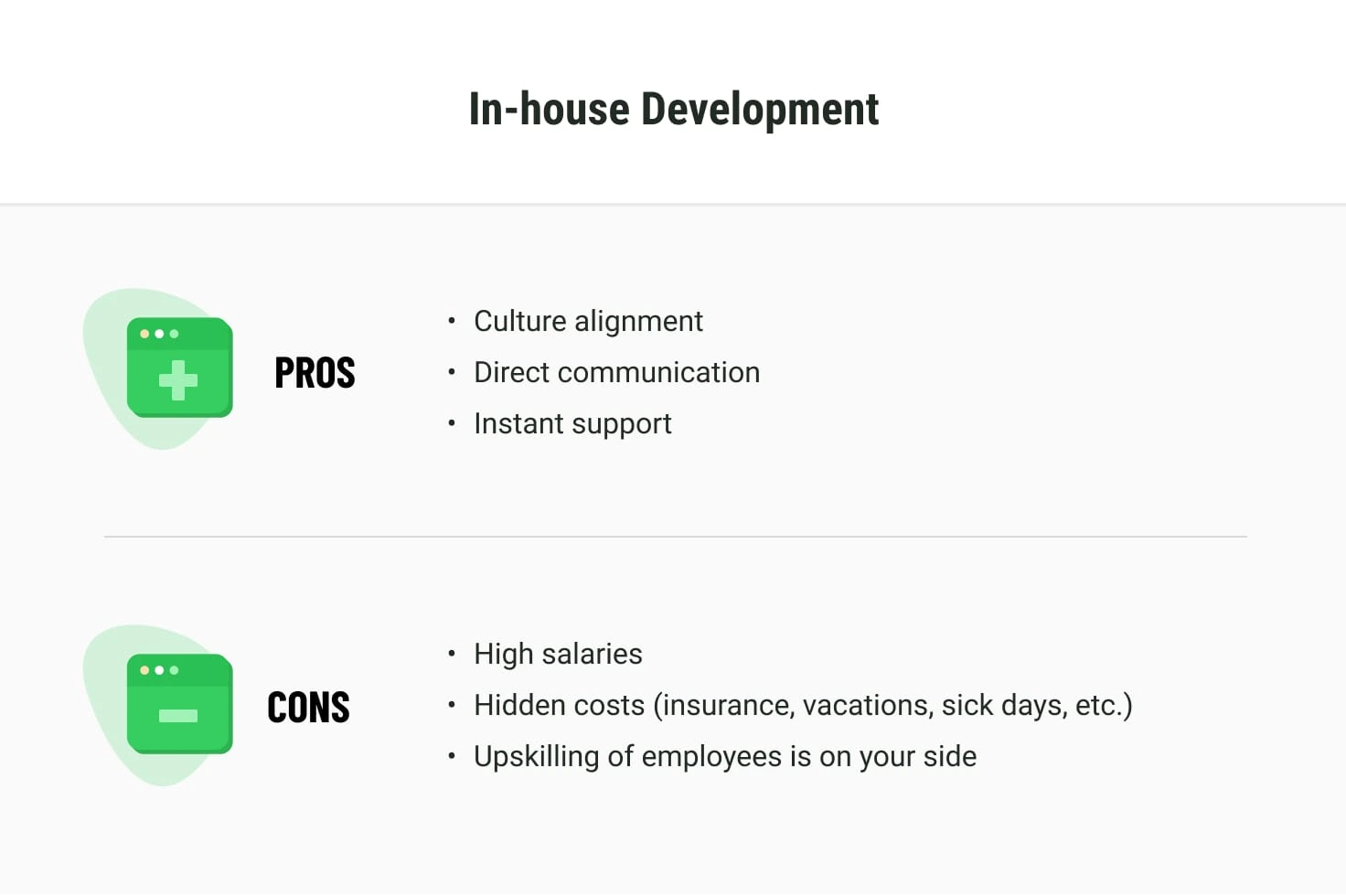In-house vs. Outsource Development: Which Model to Choose for Your Project in 2025?
Table of contents
- What Is In-House Development?
- The Pros of In-House Development
- The Cons of In-House Development
- What Is Outsource Development?
- The Pros of Outsource Teams
- The Cons of Outsource Teams
- Tips From CTO on Which Model to Choose: In-House vs. Outsourcing
- When to choose in-house
- When to choose outsourcing
- You can take the best out of two options
- Why Choose Emerline as Your Outsourcing Development Partner?
Business owners know that creating a development team can be intimidating. Generally, they must choose between two primary options: an in-house team or outsourcing.
Industry analysts forecast that by 2025, IT outsourcing will reach an astonishing $98 billion, highlighting the great potential of this engagement model. But does that make having an in-house team any less advantageous? To answer this, it's essential to look at each model's advantages and drawbacks, and we'd be delighted to assist with this.
This article highlights the major distinctions between in-house and outsourcing models and contains insights from a CTO so that you can make an informed decision. Now, let's get started with the comparison.
What Is In-House Development?
Building software with the experts already present within your company is referred to as in-house development. Every task is conducted solely by employees with no outside aid.
Forming an in-house team necessitates all the processes associated with recruiting permanent employees, with the additional obstacle of finding developers with the appropriate expertise and experience your project needs. This will involve publishing job postings, conducting interviews, and onboarding staff to create your ideal IT team.
Such a model can bring a lot of advantages for businesses that want more power over their tech products. Huge companies such as Amazon and Paypal adhere precisely to this model. However, it's important to note that its cost is usually higher than outsourcing. Nevertheless, for companies focusing on IT, this may be a prudent investment in the long term.
The Pros of In-House Development
Bringing the development in-house can benefit the company in various ways.
- First, the team can be specifically selected to ensure a culture alignment with the organization's values. This results in increased effectiveness and improved productivity of the project.
- Secondly, direct communication and immediate support are available within the same space, which enables faster and better response times. This can also help in addressing any arising issues promptly.
- Thirdly, having the development team in-house provides flexibility regarding any possible changes and enables the company to take advantage of new trends and emerging technologies.
The Cons of In-House Development
Keeping in-house development teams has hidden costs, so those looking to go this route should ensure they can handle the monetary pressure.
- Bringing a development team in-house is expensive, with a median salary of a US-based IT developer reaching up to $95,208.
- There's the issue of sick days, vacations, insurance, recruitment, and onboarding, all of which come at a cost.
- Companies must remain diligent in the competition to acquire top talent, which is already a high commodity in the IT industry and can raise payroll costs.
- The salary remains fixed when the team is idle between projects.
- Upskilling of employees also falls on the company, so investment in necessary training and tools could impact the company's finances.

What Is Outsource Development?
Outsourcing Development is a process that allows companies to hand off the task of creating a product or service to an external party instead of using their in-house resources. It's becoming increasingly popular, mainly due to its low cost and the fact it can quickly scale with the company's size.
IT services occupied 72% of the total global outsourcing contract values. And here are some great examples of how outsourcing helped well-known companies.
- Google took the first step into outsourcing, relocating 1,000 AdWords support positions to customer service centers worldwide. Its collaboration with Latin American tech services providers enabled them to produce and establish Project Ara and other related developments. Google's experience with outsourcing shows how even the most well-known names in the market can rely on external ideas and imagination to further their development and foster invention.
- Before being taken over by Facebook, WhatsApp heavily relied on external resources. The company hired numerous development teams in Eastern Europe, which allowed them to surpass competitors on popular mobile app stores like Google Play and the App Store.
- GitHub is a prime example of how outsourcing software development can pay off. Its founders had a great idea, but it required hiring specialists with a knowledge of Git, the open-source distributed version control system. Fortunately, they found Scott Chacon, who fit their criteria but was too expensive to hire full-time. So the company decided to start with an outsourcing model. What's the result? By January 2025, they had amassed 100 million active users.
The Pros of Outsource Teams
Outsourcing provides an excellent opportunity for businesses to achieve their goals at a much lower cost with fewer hassles.
- Outsourcing software development can be a great advantage when running a business in a country with higher local wages. By collaborating with IT companies from countries with considerably lower salaries, the same level of expertise can be accessed at a lower cost.
- Companies no longer have to rely on limited local talents to choose from and can instead tap into the immense global talent pool to pick the best for their project.
- Businesses no longer have to worry about finding a single person with multiple skill sets; instead, they can collaborate with several IT firms specialized in the various technologies necessary to build the software solution.
- Outsourcing is especially beneficial for MVP development and on-demand services. An in-house team of experts may not make financial sense in the short term. In contrast, outsourcing can prove invaluable for the speedy completion of the project within a relatively small budget.
The Cons of Outsource Teams
The main concerns related to the outsourcing software development process include:
- Outsourced teams only partially work for you, meaning that you have less control over the project's progress and debugging than the in-house team.
- With the information of a third party at stake, trust can become an issue; you may worry if their policies keep your provider from taking on competing projects. Nevertheless, privacy agreements and signed non-disclosures may provide legal security for your interests.
Tips From CTO on Which Model to Choose: In-House vs. Outsourcing
Choosing whether to outsource or keep an in-house team can take time due to the many factors to consider. Emerline's CTO has provided the following pieces of advice to assist you in selecting the ideal approach for your company.
When to choose in-house
When your tech project is at the core of your business strategy
If you own a business that centers around products and intends to craft something long-lasting with various modifications and a potential to scale, forming your own in-house development team is an appropriate course of action.
When you want your business to grow with a company culture
Corporate culture is not merely a trendy term but a significant element of successful app development. The primary benefit of having a fitting company culture is increased team involvement. When a team perceives themselves as fundamental components of the company development, they are more committed to the project. What's more, statistics show that over half of all managers believe that an absence of culture can be the primary factor in project lags.
When control over the project development is a priority
The in-house team would be suitable if you can't afford any problems in your project and want total control. With your own team, you can make informed choices that directly affect product development while protecting data security.
When you can afford to pay more
If you are running a large company with lots of resources to commit to establishing your online presence, bringing in a team of internal employees offers many advantages with few to no drawbacks.
When to choose outsourcing
When technology is a tool for solving a business need
Technology can be part of the core value proposition of your product or a tool to address a business need. In the first case, when it is a key factor in the core proposition, businesses may develop the solution in-house. Conversely, if technology is a vehicle to solve a business need, outsourcing software development is usually a wiser option.
When cutting costs is a priority
Budget-wise, outsourced development could be the optimal solution for businesses. By taking on this option, one's finances become much more flexible. For example, start-ups often have limited budgets, so not committing to monthly salaries allows more financial stability.
When you want to focus on your core business, not the product development
Any company must prioritize validating their concept rapidly to draw investors and top talent. Outsourcing allows you to move quickly and with considerable benefits: it keeps you from managing and onboarding developers, which is an arduous process. Instead, it allows you to focus on business, sales, and marketing elements to develop a viable company foundation before committing to costly developer salaries.
When you don’t want to be limited in the choice of specialists
When outsourcing is in play, you no longer have to limit yourself to recruiting within your vicinity. Instead, you can look for developers from around the globe who can take your project to the next level, make constructive suggestions, or develop innovative ideas to improve your product.
When you want to go to the market in the shortest time
Outsourced development is also a wise decision when launch deadlines are approaching. Outsourcing allows for taking the hassle of long training processes away and showing faster and more satisfying work outcomes. Furthermore, with the experience of the right team, unforeseen obstacles can be tackled quickly and easily. How?
The outsourcing model allows you to hire a well-coordinated team with relevant experience in your industry. The members of such a team already know how to communicate effectively with each other to achieve the best results, both in terms of timing and quality of the product under development.
When you want to be flexible and scalable
Numerous unexpected variables often intervene, making the venture run longer or cost more than initially planned. The ideal action in such scenarios is to adjust the project's scale.
Engaging with an external software development team comes with the perk of scalability, making it possible to fine-tune the workforce depending on the project's current state. It also provides flexibility with services and the ability to customize the size, budget, and technology - options that aren't available when managing an in-house team.
When you need to align business requirements and technical specifications
When unifying business objectives and technical requirements is difficult, an outsourced vendor with a business manager is advantageous. They aid in bridging the gap between the business and technical teams, making the process smoother.
You can take the best out of two options
Opting between internal or external development may be perplexing, but finding a middle path between them is a viable approach. A reliable core team can handle the project's most indispensable components while entrusting the aspects requiring technical expertise to outsourcing vendors.
This option allows more control of expenditures and flexibility in assigning resources. Moreover, it enables you to access a broader range of skilled labor.
Why Choose Emerline as Your Outsourcing Development Partner?
Emerline offers a flexible outsourcing model that caters to the various needs of our clients when they embark on software development projects. We are ready to collaborate under any of the team engagement models available.
- You can choose a dedicated development team model that perfectly fits long-term outsourcing requirements and tasks necessitating a fast team establishment. We take responsibility for all aspects related to team development and task delivery. We can include such specialists as Project Managers, Business Analysts, and Team Leaders to ensure your ability to receive constant progress updates.
- Our on-demand staff augmentation is perfect for growing startups and projects needing extra resources. This model allows you to expand your in-house IT team with top talent that follows your existing methodologies and processes.
Emerline can become your trusted technology provider due to our experience and expertise. We have been providing quality IT and software services for over a decade and have 240+ completed projects under our belt. 80% of our customers turn to us by recommendation, and being a part of LeverX, we have enough resources to cover any of your project development needs. The company has over 800 certified consultants, developers, designers, and quality assurance professionals, each with the qualifications necessary to ensure your project's success.
So if you’re considering an alternative to building an in-house team and looking for a trusted technology partner to establish your remote development team, feel free to contact us for a free consultation.
Updated on Mar 12, 2025





